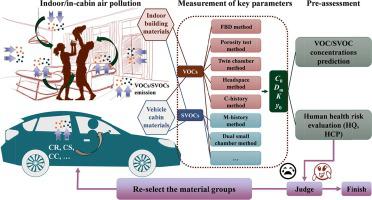Environment International ( IF 10.3 ) Pub Date : 2022-08-05 , DOI: 10.1016/j.envint.2022.107451 Haimei Wang 1 , Jianyin Xiong 1 , Wenjuan Wei 2

|
The emissions of volatile organic compounds (VOCs) and semi-volatile organic compounds (SVOCs) from indoor building and vehicle cabin materials can adversely affect human health. Many mechanistic models to predict the VOC/SVOC emission characteristics have been proposed. Nowadays, the main obstacle to accurate model prediction is the availability and reliability of the physical parameters used in the model, such as the initial emittable concentration, the diffusion coefficient, the partition coefficient, and the gas-phase SVOC concentration adjacent to the material surface. The purpose of this work is to review the existing methods for measuring the key parameters of VOCs/SVOCs from materials in both indoor and vehicular environments. The pros and cons of these methods are analyzed, and the available datasets found in the literature are summarized. Some methods can determine one single key parameter, while other methods can determine two or three key parameters simultaneously. The impacts of multiple factors (temperature, relative humidity, loading ratio, and air change rate) on VOC/SVOC emission behaviors are discussed. The existing measurement methods span very large spatial and time scales: the spatial scale varies from micro to macro dimensions; and the time scale in chamber tests varies from several hours to one month for VOCs, and may even span years for SVOCs. Based on the key parameters, a pre-assessment approach for indoor and vehicular air quality is introduced in this review. The approach uses the key parameters for different material combinations to pre-assess the VOC/SVOC concentrations or human exposure levels during the design stage of buildings or vehicles, which can assist designers to select appropriate materials and achieve effective source control.
中文翻译:

室内和车载环境材料VOC/SVOC排放关键参数测量方法及影响因素综述
室内建筑和车舱材料排放的挥发性有机化合物(VOC)和半挥发性有机化合物(SVOC)会对人体健康产生不利影响。已经提出了许多预测 VOC/SVOC 排放特性的机械模型。目前,准确模型预测的主要障碍是模型中使用的物理参数的可用性和可靠性,例如初始可排放浓度、扩散系数、分配系数以及材料表面附近的气相 SVOC 浓度。这项工作的目的是回顾现有的测量室内和车辆环境中材料中 VOC/SVOC 关键参数的方法。分析了这些方法的优缺点,并总结了文献中可用的数据集。一些方法可以确定一个关键参数,而其他方法可以同时确定两个或三个关键参数。讨论了多种因素(温度、相对湿度、装载率和换气率)对VOC/SVOC排放行为的影响。现有的测量方法跨越非常大的空间和时间尺度:空间尺度从微观到宏观不等;VOC 的室内测试时间从几个小时到一个月不等,SVOC 甚至可能跨越数年。本文介绍了基于关键参数的室内和车内空气质量预评估方法。该方法利用不同材料组合的关键参数,在建筑物或车辆的设计阶段预先评估VOC/SVOC浓度或人体暴露水平,可以帮助设计者选择合适的材料并实现有效的源控制。











































 京公网安备 11010802027423号
京公网安备 11010802027423号